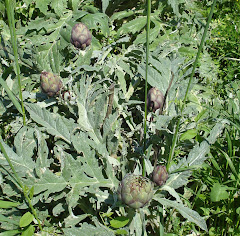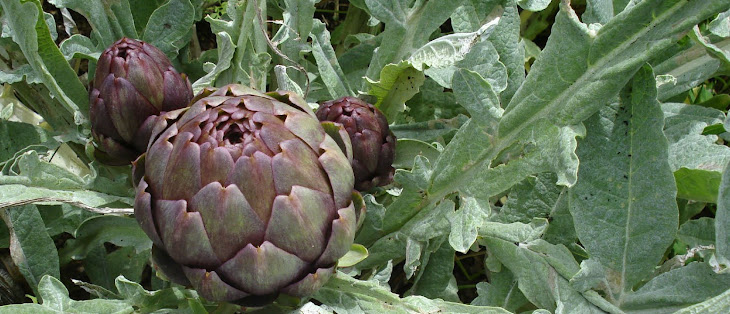Over the past few years we’ve tried many different ways of watering our garden during the hot dry summers we have here. We’ve tried a drip-feed system, mulches and terracotta pots. These work in some circumstances, but we’ve come to the conclusion that the local gardeners know best about how to cope with conditions here. Our neighbour Aimé, who watered our garden while we were away last month, uses a wide-gauge pipe running from the stream to fill his water cistern and also to water the vegetables. Between the rows he has, as we do now, deep channels so that the pepper, tomato and other plants are grown on the top of a ridge and watered in between the ridges. Today he insisted that we use his pipe instead of our puny (normal garden hose size) one and we quickly flooded the watering channels.
Obviously, this method of watering would not work for small seedlings, which can be watered with a watering can, but for the bigger stronger plants it seems to be the method that works best and we have to acknowledge that the people who know best how to garden here are those who have been gardening here for decades and whose fathers (it is still mostly the men who garden here) taught them the ways they learnt from their fathers, and so on back through the centuries. I saw similar methods used in the south of Spain, where it is even hotter and dryer than here, and where whole fields are flooded. This is what works here, but in other places, different climates, different soils, the best way to water will be different.
We’ve had a very strong north wind this week, which has made watering even more necessary as it dries out the surface of the soil. It’s also blown the olive branches about and left many small olive flowers lying on the ground. Luckily, both our olive trees still have a lot of flower on them so I don’t think the crop should be too badly affected.
 |  |
Harvesting
We’ve been eating the little Spanish habas beans, grown from seed given to us by our friend Drew in Navarra. There, he says, they are usually dried and saved for winter, but we like them fresh. They are small broad beans tightly packed into small pods, with very little waste, and they taste delicious cooked the same way as broad beans. Today I sautéed some fresh garlic in some olive oil then added the beans, a pinch of salt, a couple of sprigs of savoury and some water and cooked them until the water evaporated. There are some left over which we’ll eat cold as a salad tonight. We’ve also been picking courgette flowers – still only male flowers – to make fritters. I noticed from last year’s records that on 1 June we cooked our first courgettes on the barbecue – we’re a long way from doing that this year!
 |  |  |
And a summer lunch
Today we invited friends for lunch in the garden and ate: grilled sweet onions with romesco sauce (made with ground almonds, ground dried pimento peppers, sweet red peppers, garlic and olive oil); chicken pieces marinaded in paprika, cumin, oregano, olive oil and garlic, with grilled aubergine slices; the beans I mentioned above; Mont St Pierre cheese from Lacaune; strawberries and an apple tart brought by our friends; and a few glasses of rosé and red wine. Sorry, no photos – we were having too much fun – but I’ll probably photograph all these when we cook them again over the summer.










5 comments:
I water slightly differently, by planting in the channel. It wouldn't work in a wetter climate though, as the plants could get waterlogged, but I find it's the best way here as we have very free-draining soil.
Jan: I think our method encourages the plants to grow deeper roots because the water isn't on the surface around them. Also, it doesn't wash away the soil around the stems.
Here in Australia many gardeners who have come here from Italy, water in the way you have described.
I'm with Jan on the watering system, which is also used by our neighbours. I think it might depend on soil type too. We have very heavy soil which doesn't get washed away easily and is difficult for the roots to penetrate with ease. Just a theory.
Yes, Heiko, I think what I was trying to say in this post is that we should learn from those who are gardening where we are, as they know best. We have light limestone soil, very different from yours.
Post a Comment